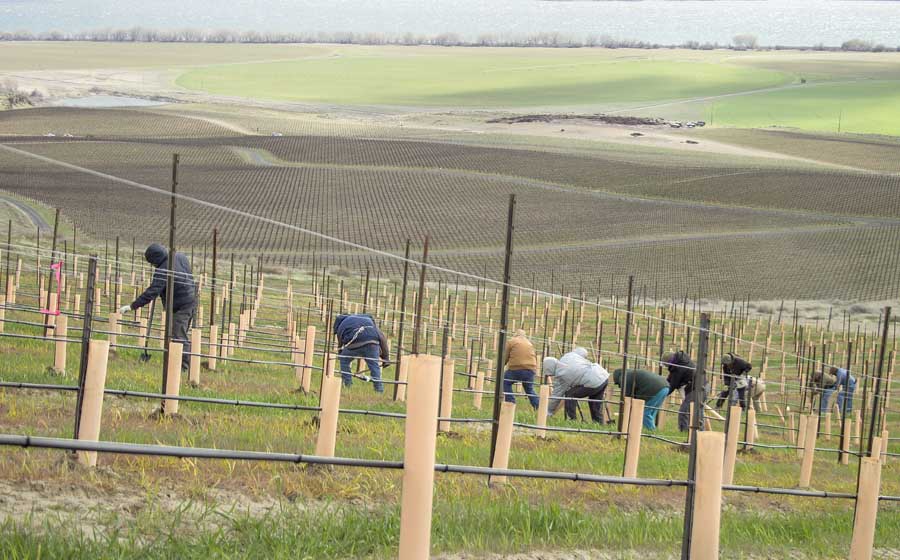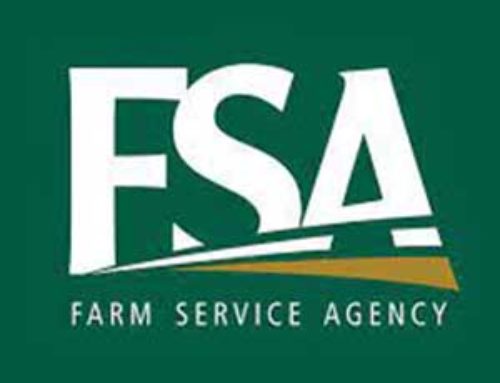
Workers at Ste. Michelle Wine Estates’ Canoe Ridge Vineyard near Paterson, Washington, plant Cabernet Sauvignon vines in March 2016. Ste. Michelle, the largest wine company in the state, estimates it will be need to replant and replace 5 percent of its vineyards each year to weed out aging or diseased vines and help to stay abreast of varietal trends. (Shannon Dininny/Good Fruit Grower)
The largest player in Washington’s wine industry, Ste. Michelle Wine Estates, estimates it will need to replace 5 percent of its grapevines each year to replace aging or diseased vines and help to stay abreast of varietal trends. And that doesn’t include what the company might want to plant to increase its acreage.
What does that mean for the rest of the industry?
“No man is an island, and no wine grape is either,” said Vicky Scharlau, executive director of the Washington Association of Wine Grape Growers. “It affects everybody else. Ste. Michelle is so large that when this ship moves, everybody gets a different view.”
Today, Washington is the nation’s second-largest producer of premium wine, with more than 900 wineries and 50,000 acres planted in wine grapes — a fraction of the 600,000-plus acre industry in California, but a growing segment of Washington’s agricultural economy nonetheless.
In the late 1960s, fewer than 500 acres of wine grapes were grown in Washington. Growers really didn’t start investing in large-scale plantings until the 1970s and 1980s, but that means many of those vines need to replaced, for various reasons.
Large blocks of Ste. Michelle vines were planted from 1973 to 1992. “But there’s also this big lump of planting that happened toward the end of the ’90s. If you have vineyards that were planted at that time, you know that a lot of virus moved around, and they are on a premature decline and really need to be replanted, too,” Kevin Corliss, Ste. Michelle’s vice president of vineyards, said at a November WAWGG seminar on industry growth and the need for clean plants.
“We’re getting into the end of our first generation of vineyards now,” he said. “I figure if just 5 percent needed to be replanted each year — that’s replacing vines that are diseased, old systems, varieties people don’t want anymore — just for our vineyards, we need 1.75 million vines. That’s a big number. That’s a base number and doesn’t include vines needed for expansion.”
Highest demand is anticipated to be for Cabernet Sauvignon vines.
From 2005 to 2015, Cabernet Sauvignon sales nationally grew almost threefold, from $364 million to $935 million, according to Nielsen data. In addition, sales of red wine blends increased from $79 million to $590 million over the same time period.
“Cabernet is king,” Corliss said. “That’s what the market wants, that’s the prestige variety around the world, especially the United States.” Consumers also increasingly are willing to pay a higher price, $20 to $30 per bottle, for Cabernet, and Washington fits into that niche nicely, he said.
“This is phenomenal growth, and we’re seeing this growth in good, profitably priced bottles of wine, which is also important,” he said. “It’s not at the high end or the low end; it’s the moderately priced bottles in the middle, where Washington competes quite well.”
That demand puts added pressure on one of the industry’s highest needs: clean plants. Increasingly, researchers and industry groups are working to educate growers about virus risks and symptoms and the need to source clean plants for their vineyards, Scharlau said.
In the months ahead, Good Fruit Grower will feature articles on those topics to help growers stay abreast of the latest virus research and to offer tips for sourcing clean plants and replanting vineyards. •
WAWGG annual meeting to be held Feb. 7-9
Industry growth also will be a leading topic at the annual meeting of the Washington Association of Wine Grape Growers Feb. 7-9 in Kennewick, Washington.
In addition to talks about global growth and demand, speakers will offer guidance on sourcing clean plants, caring for new grafts, and managing pests, diseases, irrigation and crops in cold vs. warm years.
On the winery side, vintners can expect talks focusing on microbial spoilage of wine — and detecting and preventing it — as well as the phenolics of Washington state wines.
Good Fruit Grower will provide daily updates from the convention online at goodfruit.com. For a complete list of speakers and presentation, visit wawgg.org.
– by Shannon Dininny






Leave A Comment